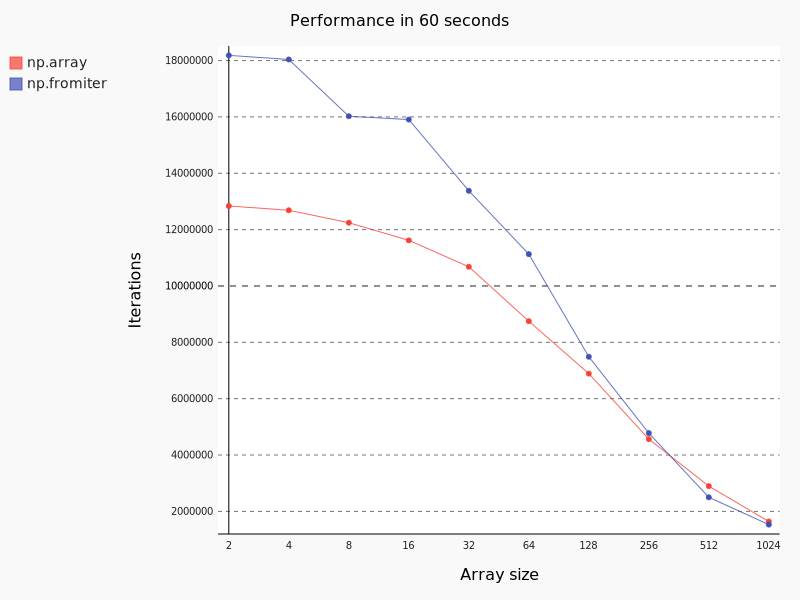NumPy: Faster initialization
Introduction
NumPy is the fundamental package for scientific computing with Python. It contains among other things:
- a powerful N-dimensional array object
- sophisticated (broadcasting) functions
- tools for integrating C/C++ and Fortran code
- useful linear algebra, Fourier transform, and random number capabilities
In this article, we’ll focus on the initialization of NumPy arrays.
Context
Usually, to create a NumPy array, you will use the numpy.array function but there is another way to do
it: numpy.fromiter. The main difference is that numpy.fromiter can take any iterable, if your class
implements __iter__, you can pass it to numpy.fromiter.
Note, numpy.fromiter only work with 1-dimensional array.
In this post, I benchmark performance between these two methods of initialization. Tests are done on Ubuntu 16.04 with Python 3.6 and NumPy 1.11.3.
At first glance, you may think that fromiter is slower but you will be surprised.
Show me the code !
Here is the code to benchmark:
#!/usr/bin/env python3.6
import time
import numpy as np
import pygal
from os import path
list_sizes = [2**x for x in range(1, 11)]
seconds = 60
def test(size_array):
pyarray = [float(x) for x in range(size_array)]
# fromiter
start = time.time()
iterations = 0
while time.time() - start <= seconds:
np.fromiter(pyarray, dtype=np.float32, count=size_array)
iterations += 1
fromiter_count = iterations
# array
start = time.time()
iterations = 0
while time.time() - start <= seconds:
np.array(pyarray, dtype=np.float32)
iterations += 1
array_count = iterations
return array_count, fromiter_count
results = {}
for size_array in list_sizes:
res = test(size_array)
results[str(size_array)] = res
print(f"Result for size {size_array} in {seconds} seconds: {res}")
out_folder = path.dirname(path.realpath(__file__))
print(f"Create diagrams in {out_folder}")
chart = pygal.Line()
chart.title = f"Performance in {seconds} seconds"
chart.x_title = "Array size"
chart.y_title = "Iterations"
chart.x_labels = list(results.keys())
chart.add('np.array', [x[0] for x in results.values()])
chart.add('np.fromiter', [x[1] for x in results.values()])
chart.render_to_png(path.join(out_folder, f'result_{seconds}.png'))
To be able to execute this code, install numpy, pygal and cairosvg packages.
This code creates a maximum number of NumPy arrays in 60 seconds. The array size is
increased several times.
Result

On this graph, the higher the better. What you see is that numpy.fromiter is faster
than numpy.array until array of size 256.
I don’t know how these two functions differ but I can recommend you to use fromiter
for small arrays.
Let me know what you think of this article on twitter @realitix!